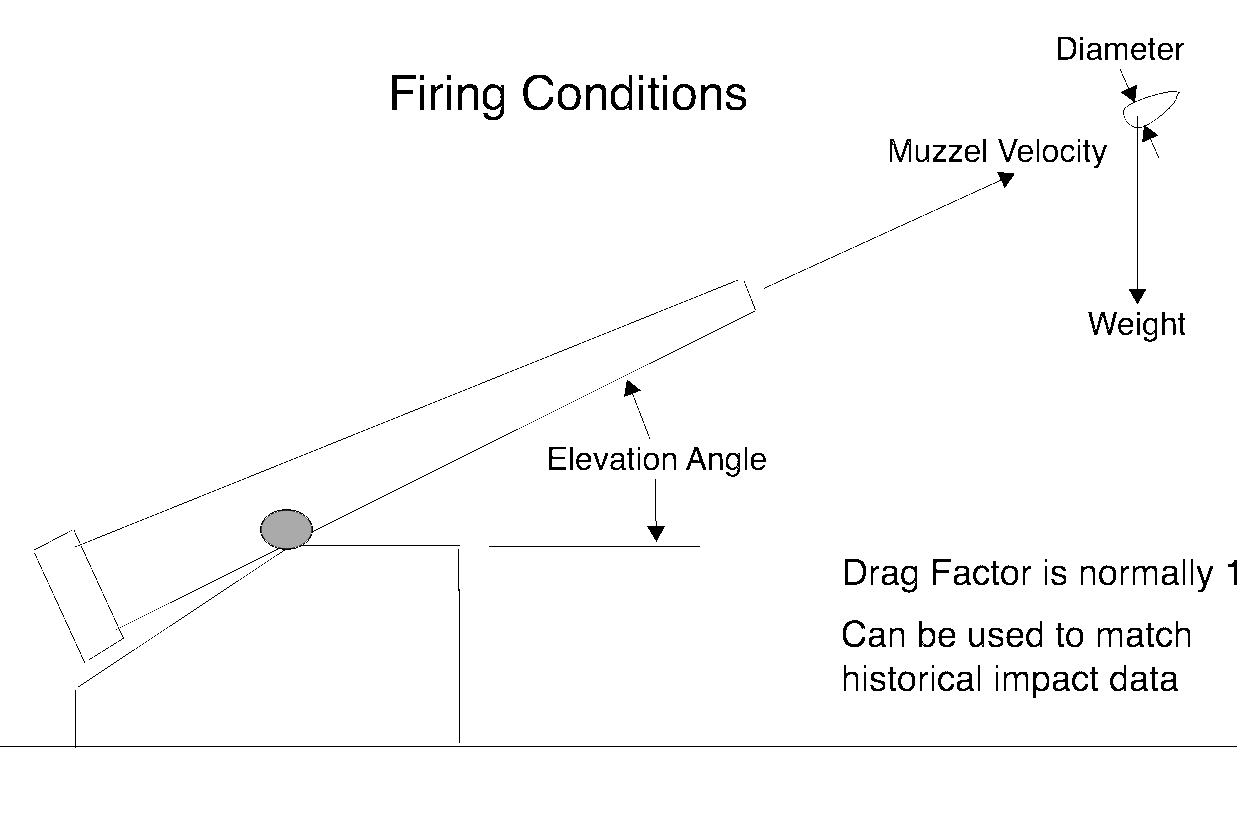Naval Cannon Ballistic Analysis
Using the Bashforth Equation, 1885
by Paul F. Watson
Introduction: This webpage contains a "live" computer program that calculates cannon shell impact conditions for naval vessels (range, velocity, angle and flight time). It is based on the historical 1885 Bashforth Equation; but, will still give realistic results. It is here for your use! If you have JavaScript as in your browser (likely yes), it should work. Just run the analysis right from this web page see! Very brief instructions are provided below.
Instructions:
- Fill in the blanks for the form below.
- A table below will show you values for Drag Factor you should use. Just find a case example from the table with similar date to your problem, and use the 'drag factor' in the 3rd column (e.g. type in .85)
- Realistic battle ranges are far less than maximum range (firing angle about 2 degrees to 20 degrees), so unless you are bombarding a city, you will never elevate the gun over 20 degrees. For extreme ranges (like city bombardment), I have added air density changes as a function of altitude to the original bashforth equation. As a result, use of the same Drag Coefficient for all ranges will produce fairly accurate results.
- Below is a gun picture. It is labeled to identify all the input values (weight w, muzzel velocity etc.) for the form. Fill in all the values in the form. If there is something you don't know, just leave it blank and run the program anyway (because I have put in realistic default values).
- Then click the "Do It!" button.
- An 'alert window' will pop up after about one second & tell you the range in feet.
- Click the 'OK' button
- All the answers (range, impact velocity etc. will populate on web page below!
- To re-run the problem with a couple of changes, just make the form corrections & click "Do It!"
| Case Example |
Nation |
DF for angle |
Range ft Hist. |
Reference |
Brit Cannons 24# & 32#
5.55 & 6.10" |
U.K. |
~1.2 |
~1920 @ 5 deg |
5 |
Trafalgar 1890
13.5" |
U.K. |
.79 |
~35850 @ 13.5 deg |
2 |
Nelson 1905
12" |
U.K. |
.85 |
~49200 @ 13.5 deg |
2 |
WWI 1908-1914
13.5" & 14" |
U.K. |
.52 |
~69300 @ 20 deg |
3 |
WWI 1908-1914
11" & 12" |
Germany |
.61 |
~60000 @ 16 deg |
3 |
Post WWI New Mexico 1918
14" |
U.S. |
.45 |
~75000 @ 15 deg |
4 |
Interwar 1931
Dunkerque 13" |
France |
.4 |
~83000 @ 15 deg |
4 |
WWII 1940 Vitorio
Veneto 15" |
Italy |
.4 |
~86000 @ 15 deg |
4 |
WWII King
George V 1940 14" |
U.K. |
.49 |
~64500 @ 15 deg |
4 |
WWII North
Carolina 1941 16" |
U.S. |
.45 |
~63000 @ 15 deg |
4 |
Ogival head
radius=1.0 calibre |
French Testing |
1.026 |
TBD |
1 |
Ogival head
radius=1.5 calibre |
Interpolation |
1.00 |
30442 note 1 |
1 |
Ogival head
radius=2.0 clibre |
French Testing |
.97433 |
TBD |
1 |
Hemispherical
head |
N/A |
1.243 |
27923 note 1 |
1 |
Flat
head |
N/A |
1.88 |
N/A |
1 |
Typical Drag Factors
Find something similar to your problem & use the value
Note 1: Range was analyzed for muzzel velocity = 2000 ft/sec and gun elevation = 13.5 deg bore=12" w=864 lb
Note 2: Gun elevation for battleship primary batteries was generally restricted by gun mount construction. Early British ships generally were
restricted to 16.5 degrees elevation. King George V in 1940 was restricted to 30 degrees.
Note 3: The longest range hit ever recorded was in the Mediterranean Sea when HMS Warspite hit an Italian battleship at 25000 yards with a 15 inch shell. This suggests that analysis of firing angles resulting in ranges over 25000 yards are generally irrelivant. i.e. over 25000 yards, a battleship is unlikely to hit an opposing ship.


Projectile Impact Solution:
Analysis Description:
Range at impact ft :
Impact Velocity ft/sec:
Impact Angle deg:
Flight time sec:
Danger Interval in ft:
In the future, I will add a link to a web page explaining the historical Bashforth equation & a few comments about how this approach differs from modern day analysis approaches.
A second future article will discuss & explain the importance to gunnery of each of the outputs of this analysis. For example, a flight time of 30 seconds guarantees the enemy vessel will move beyond the "aiming point" and shells will fall behind. This was the reason mechanical fire control computers were designed and implemented before the start of WWI.
References:
- Exterior Ballistics 1885 by Lieutenants J.F. Meigs, U.S.N. and R.R. Ingersol, U.S.N. 1885 (page 20)
- British Battleships 1889-1904 by R. A. Burt, Naval Institute Press, Annapolis, Maryland, copyright 1988 by R.A. Burt (pages 45-46)
- Jutland, An Analysis of the Fighting by John Campbell, Published in the U.S. by Naval Institute Press, copyright 1986 (table Chapter 18)
- United States Battleships in World War II by Robert O. Dulin and Jr., William H Garzke, Jr., copyright 1976 by U.S. Naval Institute (Appendix C)
- Seacoast Fortifications of the United States, by Emanuel Raymond Lewis,(c) 1970, Naval Institute Press
Contact the author
paul-watson@sbcglobal.net
by e-mail.
© 2020 (updated April 2020) to output Danger Intervals
All Rights Reserved
Paul F. Watson
Dionysus.biz Home Page